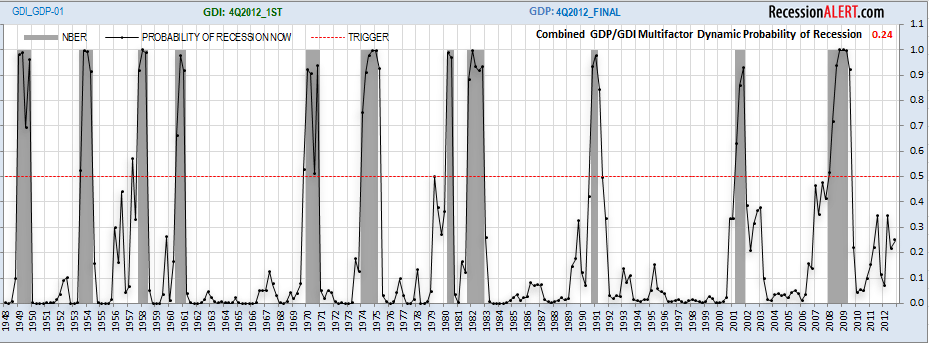ilene04/12/2013 - 01:00Typically the public enters the market after a large run up, in time to buy at the top. Not there yet.The actual article (LINK) provides the conventional view:
Typically the public enters the market only after a large run up, just in time to buy at the top. Investors might get luckier in today's situation if American stocks start behaving more like the Nikkei 225 index. US equities have plenty of room to run simply as hedges against massive money-printing by Chairman Bernanke.But this view is demonstrably incorrect. If Fed actions require hedging, presumably because they are inflationary (by definition under Austrian economics), then soon enough interest rates will do what they did in the US in the 1960s and '70s and rise. This will bring down P/E's and the inflation tends to lead to shrinking profit margins. So all you can predict in that scenario is that stocks will outperform long-term bonds.
Reluctant bulls, but bulls nonetheless, are everywhere. ECRI is one. A competitor, RecessionAlert, presents a variant of that stance. While showing a long-term chart of its (back-tested) forecasting tools, it makes sure to denigrate any recession that the US might be in as "technical". Sorry for the formatting of the next chart, see link:
The chart above shows the current "recovery" as the only one never to have the chance of the economy actually being in a recession go to zero. (The economist estimates that the US actually has, or recently had, a 24% chance of being in a recession. Do you think the stock market thinks so?) Perhaps the 1930s had that pattern. In any case, this economist's view is reassuring. Sure, the US might be in a technical recession, but don't worry, his cyclical indicators show that it will be mild.
And then all shall be well forever? Or will there just be another period of moderate growth, inventory replenishment, etc., as in the past 4 years, all fueled again by Fed largesse? What P/E do those profits merit? Recession Alert is probably giving you a similar message to ilene. Yes, the economy isn't so good, but things will turn around. Why lose ground to inflation in bonds or cash/trash? (Note please that I'm guessing, as I'm not a subscriber. But in general, whenever a stock-oriented economist tells you that his short and long leading indicators are looking up and that a recession will be technical (not even "mild", just "technical"), I assume that he's basically a bull.
In summary, the latest "hook" for the stock market as a whole is that it is so close to its old highs, and people aren't boasting over the dinner table about XYZ stock making them a lot of money, so it doesn't smell like a top. Meanwhile, the old standby of Smithers et al looks like now a poor time to put money into the market from a longer-term perspective, though we might indeed by in a 1928/9 or 1998/9 era with yet higher highs for a period:
With the publication of the Flow of Funds data up to 31st December, 2012 (on 7th March, 2013) we have updated our calculations for q and CAPE. Over the past year net worth has risen by 7.6%, with the most significant rise being in the value ascribed to real estate (+ 5.9%). Interest-bearing assets have risen by 5.8% while interest-bearing liabilities have risen by 8.2%.All we have standing behind this level of overvaluation and going to cash, or munis, is the fact that the Fed is "easy". Given what's happened to Japanese stocks between 1995 and 2012, when the Bank of Japan was almost always "easy", that's a thin reed.
Both q and CAPE include data for the year ending 31st December, 2012. At that date the S&P 500 was at 1426 and US non-financials were overvalued by 44% according to q and quoted shares, including financials, were overvalued by 52% according to CAPE. (It should be noted that we use geometric rather than arithmetic means in our calculations.)
As at 12th March, 2013 with the S&P 500 at 1552 the overvaluation by the relevant measures was 57% for non-financials and 65% for quoted shares.
Although the overvaluation of the stock market is well short of the extremes reached at the year ends of 1929 and 1999, it has reached the other previous peaks of 1906, 1936 and 1968.
It must be said that there are some crash-callers out there. But the media has to look hard to find them. There were also housing crash-callers who got some publicity as the bubble got very large. The problem with crash-callers is that they get excited too soon, then they get ignored.
The metals are collapsing, including both gold and copper. That tells me a lot about the state of global liquidity (gold) and industrial vigor (copper). This could be another 2011, at the least.
Cash may no longer be trash.

"That tells me a lot about the state of global liquidity (gold)"
ReplyDeleteCould you expand on that? I think I know what you mean but I'd rather hear how you tie that together.
As for predicting recessions I ran across something interesting while looking at a chart on John Cochrane's blog. http://johnhcochrane.blogspot.com/2013/04/interest-rate-graphs.html
I noticed the cycles of compression and expansion in interest rates and decided to plot it on FRED. Plot (WGS10YR - WTB3MS) on FRED using the weekly data.
The spread converges to zero (or lower) before a recession and expands to about 3% at the end. The relationship holds going back the entire data set.
I haven't played around with moving averages or even looked at how far in advance these signals occur. This just sort of fell out yesterday while I was looking at the first chart of his post.